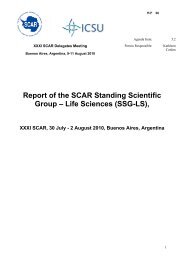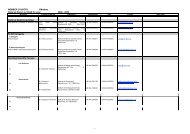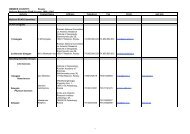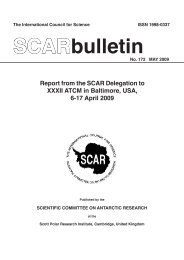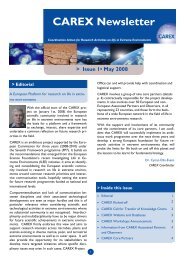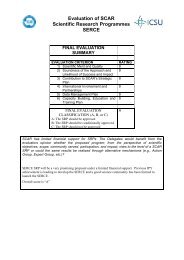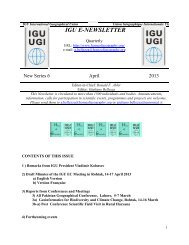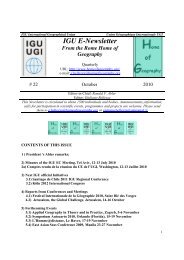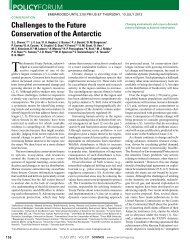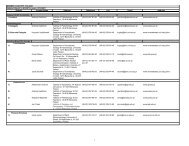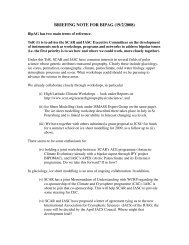Minutes of joint SCADM/SCAGI meeting - Scientific Committee on ...
Minutes of joint SCADM/SCAGI meeting - Scientific Committee on ...
Minutes of joint SCADM/SCAGI meeting - Scientific Committee on ...
You also want an ePaper? Increase the reach of your titles
YUMPU automatically turns print PDFs into web optimized ePapers that Google loves.
<str<strong>on</strong>g>Minutes</str<strong>on</strong>g> <str<strong>on</strong>g>of</str<strong>on</strong>g> <str<strong>on</strong>g>joint</str<strong>on</strong>g> <str<strong>on</strong>g>SCADM</str<strong>on</strong>g>/<str<strong>on</strong>g>SCAGI</str<strong>on</strong>g> <str<strong>on</strong>g>meeting</str<strong>on</strong>g> <br />
7‐9 th September 2009 <br />
Trippenhuis, Amsterdam <br />
<br />
The <str<strong>on</strong>g>meeting</str<strong>on</strong>g> took the format <str<strong>on</strong>g>of</str<strong>on</strong>g> a <str<strong>on</strong>g>joint</str<strong>on</strong>g> <str<strong>on</strong>g>meeting</str<strong>on</strong>g> <strong>on</strong> the morning <str<strong>on</strong>g>of</str<strong>on</strong>g> 7 th September, <br />
all day <strong>on</strong> the 8 th September until mid afterno<strong>on</strong> <strong>on</strong> 9 th September. <str<strong>on</strong>g>SCADM</str<strong>on</strong>g> and <br />
<str<strong>on</strong>g>SCAGI</str<strong>on</strong>g> had individual business <str<strong>on</strong>g>meeting</str<strong>on</strong>g>s <strong>on</strong> the afterno<strong>on</strong>s <str<strong>on</strong>g>of</str<strong>on</strong>g> 7 th September and <br />
9 th September. <br />
<br />
Invited Guests: <br />
Colin Summerhayes ‐ SCAR <br />
Mike Sparrow ‐ SCAR <br />
Volker Rachold ‐ IASC <br />
Mark Pars<strong>on</strong>s – IPY Data <str<strong>on</strong>g>Committee</str<strong>on</strong>g> <br />
Martin Loss – NWO <br />
Ad Huiskes ‐ SCAR <br />
<br />
Invited Speakers: <br />
Ant<strong>on</strong>io Quesada (Biologist – SCAR) <br />
T<strong>on</strong>y Phillips (Physical Scientist – SCAR) <br />
Ian Jacks<strong>on</strong> (OneGeology) <br />
Paul Morin (University <str<strong>on</strong>g>of</str<strong>on</strong>g> Minnesota) <br />
<br />
<br />
Day 1 – 7 th September <br />
Agenda items 1 – 3 (welcome and opening remarks, overview <str<strong>on</strong>g>of</str<strong>on</strong>g> <str<strong>on</strong>g>meeting</str<strong>on</strong>g> <br />
activities and goals, and housekeeping) <br />
The <str<strong>on</strong>g>meeting</str<strong>on</strong>g> commenced with a welcome to Amsterdam and the Trippenhuis by <br />
Martin Loss from the Royal Netherlands Academy <str<strong>on</strong>g>of</str<strong>on</strong>g> Arts and Sciences. <br />
Kim Finney : <br />
• thanked Taco de Bruin for organising the <str<strong>on</strong>g>meeting</str<strong>on</strong>g>, and hosting the <str<strong>on</strong>g>SCADM</str<strong>on</strong>g> <br />
and <str<strong>on</strong>g>SCAGI</str<strong>on</strong>g> <str<strong>on</strong>g>meeting</str<strong>on</strong>g>s in Amsterdam. <br />
• welcomed Colin Summerhayes and Mike Sparrow from SCAR, Volker <br />
Rachold from IASC, Ad Huiskies from SCAR Excom, and Mark Pars<strong>on</strong>s <br />
from the IPY Data <str<strong>on</strong>g>Committee</str<strong>on</strong>g>. <br />
• Noted that this was a historic <str<strong>on</strong>g>meeting</str<strong>on</strong>g> as it was the first <str<strong>on</strong>g>of</str<strong>on</strong>g>ficial <str<strong>on</strong>g>joint</str<strong>on</strong>g> <br />
<str<strong>on</strong>g>meeting</str<strong>on</strong>g> <str<strong>on</strong>g>of</str<strong>on</strong>g> <str<strong>on</strong>g>SCADM</str<strong>on</strong>g> and <str<strong>on</strong>g>SCAGI</str<strong>on</strong>g>. <br />
• Introduced the structure <str<strong>on</strong>g>of</str<strong>on</strong>g> <str<strong>on</strong>g>meeting</str<strong>on</strong>g>, and the three guest speakers, <br />
Ant<strong>on</strong>io Quesada, T<strong>on</strong>y Phillips and Ian Jacks<strong>on</strong> and gave a brief overview <br />
<str<strong>on</strong>g>of</str<strong>on</strong>g> aims <str<strong>on</strong>g>of</str<strong>on</strong>g> <str<strong>on</strong>g>meeting</str<strong>on</strong>g> <br />
<br />
Henk Brolsma thanked the hosts, and welcomed new members <str<strong>on</strong>g>of</str<strong>on</strong>g> <str<strong>on</strong>g>SCAGI</str<strong>on</strong>g>. <br />
Taco de Bruin welcomed all attendees to Amsterdam and the Trippenhuis, and <br />
introduced logistical arrangements for the <str<strong>on</strong>g>meeting</str<strong>on</strong>g>. <br />
<br />
<br />
1
2<br />
Agenda item 4 (Presentati<strong>on</strong> by SCAR Executive Director (Colin <br />
Summerhayes)) <br />
Colin Summerhayes gave a brief introducti<strong>on</strong> to the work <str<strong>on</strong>g>of</str<strong>on</strong>g> SCAR, and the <br />
outcomes <str<strong>on</strong>g>of</str<strong>on</strong>g> the data discussi<strong>on</strong>s at the recent SCAR Executive <str<strong>on</strong>g>Committee</str<strong>on</strong>g> <br />
<str<strong>on</strong>g>meeting</str<strong>on</strong>g>. Coordinati<strong>on</strong> <str<strong>on</strong>g>of</str<strong>on</strong>g> data and informati<strong>on</strong> are an important role for SCAR, <br />
and EXCOM see data as fundamental to the way we do science. He emphasised <br />
the importance <str<strong>on</strong>g>of</str<strong>on</strong>g> presenting the DIMS at the next ATCM to explain how it will <br />
provide benefits for all Parties [ACTION 1]. <br />
<br />
He went <strong>on</strong> to explain that SCAR and COMNAP will be <str<strong>on</strong>g>meeting</str<strong>on</strong>g> so<strong>on</strong> to develop <br />
more mutually beneficial working arrangements, and will also c<strong>on</strong>duct <br />
discussi<strong>on</strong>s <strong>on</strong> links with <str<strong>on</strong>g>SCADM</str<strong>on</strong>g> and <str<strong>on</strong>g>SCAGI</str<strong>on</strong>g>. <str<strong>on</strong>g>SCADM</str<strong>on</strong>g> and <str<strong>on</strong>g>SCAGI</str<strong>on</strong>g> will also play an <br />
important role in the new developing Strategic Plan for SCAR. A <str<strong>on</strong>g>meeting</str<strong>on</strong>g> to <br />
progress the development <str<strong>on</strong>g>of</str<strong>on</strong>g> the new SCAR strategic plan will be held in early <br />
2010 in Cambridge. <br />
<br />
Colin talked about the progress which had been made in promoting the status <str<strong>on</strong>g>of</str<strong>on</strong>g> <br />
<str<strong>on</strong>g>SCADM</str<strong>on</strong>g> and <str<strong>on</strong>g>SCAGI</str<strong>on</strong>g> which are both now standing committees within SCAR. He <br />
pointed out that this shows a recogniti<strong>on</strong> <str<strong>on</strong>g>of</str<strong>on</strong>g> the permanent and <strong>on</strong>going <br />
requirement for data and informati<strong>on</strong> work in SCAR. He said that <str<strong>on</strong>g>SCAGI</str<strong>on</strong>g>’s work <br />
was well recognised and apprecietd by SCAR EXCOM. <br />
<br />
Colin highlighted that many global bodies now have programmes which include <br />
Antarctic Science, and SCAR must recognise this and work with these <br />
organisati<strong>on</strong>s to form better partnerships. This is also being reflected in the <br />
SCAR DIMS, which highlights the growing relati<strong>on</strong>ships with, for example, <br />
CODATA and GBIF. He also highlighted the importance <str<strong>on</strong>g>of</str<strong>on</strong>g> close relati<strong>on</strong>ships <br />
with the Arctic community. <br />
<br />
He encouraged <str<strong>on</strong>g>SCADM</str<strong>on</strong>g> and <str<strong>on</strong>g>SCAGI</str<strong>on</strong>g> to interact more with the science community <br />
through attending the various science symposiums which the SCAR science <br />
community runs. They should be used as an opportunity to bring the data <br />
message to the science communities. <br />
<br />
He also highlighted the SCAR fellowship programme, and recommended that the <br />
data community could use this for development opportunities, and progressing <br />
implementati<strong>on</strong> <str<strong>on</strong>g>of</str<strong>on</strong>g> the DIMS [ACTION 2] <br />
<br />
Colin then pointed out that data is becoming increasingly important at EXCOM <br />
level. He reported that EXCOM were extremely pleased to receive and endorse <br />
the new DIMS, and c<strong>on</strong>gratulated Kim <strong>on</strong> having led its producti<strong>on</strong>. It places <br />
SCAR very effectively in global efforts in data management for science. He <br />
highlighted the importance <str<strong>on</strong>g>of</str<strong>on</strong>g> getting the draft SCAR data policy endorsed <br />
[ACTION 3]. Colin highlighted that as we are all volunteers, manpower is needed <br />
to take forward implementati<strong>on</strong> <str<strong>on</strong>g>of</str<strong>on</strong>g> the policy, and he promoted the need for <br />
sec<strong>on</strong>dments to work <strong>on</strong> strategy implementati<strong>on</strong>, as is recommended in the <br />
DIMS. Kim and Colin will be sending out a letter to nati<strong>on</strong>al c<strong>on</strong>tacts to advance <br />
this [ACTION 4]. He highlighted the suggesti<strong>on</strong> that had been agreed at EXCOM, <br />
that a dem<strong>on</strong>strati<strong>on</strong> project should be used to show how strategy
3<br />
implementati<strong>on</strong> can help SCAR science. He encouraged all <str<strong>on</strong>g>SCADM</str<strong>on</strong>g> and <str<strong>on</strong>g>SCAGI</str<strong>on</strong>g> <br />
members to gain further nati<strong>on</strong>al approval for the strategy [ACTION 5]. The <br />
strategy will also be promoted through the Notes from the President. <br />
<br />
Colin recommended that SCAR products need to be managed in a more coherent <br />
way, and should be brought in line with implementati<strong>on</strong> <str<strong>on</strong>g>of</str<strong>on</strong>g> the strategy. To <br />
reflect this, <str<strong>on</strong>g>SCADM</str<strong>on</strong>g> have been asked by EXCOM to carry out a review <str<strong>on</strong>g>of</str<strong>on</strong>g> SCAR <br />
products [ACTION 6]. Finally, he highlighted the IPY legacy points, <str<strong>on</strong>g>of</str<strong>on</strong>g> which data <br />
is <strong>on</strong>e, and the need to <str<strong>on</strong>g>SCADM</str<strong>on</strong>g> to remain close to the work <strong>on</strong> the IPY legacy. <br />
<br />
Helen Campbell highlighted that the DIMS had raised expectati<strong>on</strong>s <strong>on</strong> <str<strong>on</strong>g>SCADM</str<strong>on</strong>g>, <br />
and we therefore need to manage these expectati<strong>on</strong>s, and successful <br />
implementati<strong>on</strong> will require involvement <str<strong>on</strong>g>of</str<strong>on</strong>g> all NADCs. <br />
<br />
Henk Brolsma then agreed with this point and highlighted the importance <str<strong>on</strong>g>of</str<strong>on</strong>g> <br />
collaborati<strong>on</strong> <strong>on</strong> implementing the strategy, and not just attending <str<strong>on</strong>g>meeting</str<strong>on</strong>g>s. <br />
<br />
On behalf <str<strong>on</strong>g>of</str<strong>on</strong>g> the SCAR President, Henk Brolsma then presented two SCAR <br />
certificates <str<strong>on</strong>g>of</str<strong>on</strong>g> appreciati<strong>on</strong> acknowledging the l<strong>on</strong>g‐term and excellent services <br />
provided by Chiara Ramorino and Roberto Cervellati, both from Italy. <br />
<br />
Henk also presented how names in the SCAR CGA can now be viewed using <br />
Google Earth. It visually highlights the problem <str<strong>on</strong>g>of</str<strong>on</strong>g> the same features being given <br />
different coordinates by different countries. <str<strong>on</strong>g>SCAGI</str<strong>on</strong>g> is in the process <str<strong>on</strong>g>of</str<strong>on</strong>g> writing to <br />
the nati<strong>on</strong>al committees to ask for them to accept changes to locati<strong>on</strong>s to rectify <br />
some <str<strong>on</strong>g>of</str<strong>on</strong>g> these problems [ACTION 7]. <br />
<br />
The <str<strong>on</strong>g>meeting</str<strong>on</strong>g> then divided into the separate <str<strong>on</strong>g>SCADM</str<strong>on</strong>g> and <str<strong>on</strong>g>SCAGI</str<strong>on</strong>g> <str<strong>on</strong>g>meeting</str<strong>on</strong>g>s. <br />
<br />
Agenda item 5 AMD, Portals, Statistics, Future Plans (Stephanie Grebas – <br />
GCMD) <br />
Stephanie presented statistics <strong>on</strong> use <str<strong>on</strong>g>of</str<strong>on</strong>g> the AMD, ways to search for metadata <strong>on</strong> <br />
the AMD, and ways to c<strong>on</strong>tribute metadata. The presentati<strong>on</strong> showed the <br />
c<strong>on</strong>tent growth in the AMD – there has been a 20% increase since 2008 (possibly <br />
largely through NZ c<strong>on</strong>tributi<strong>on</strong>s). 46% <str<strong>on</strong>g>of</str<strong>on</strong>g> records provide access to data <br />
through the Get Data link. Astrophysics keywords can be accessed from the toplevel navigati<strong>on</strong> – it was explained that these two sets <str<strong>on</strong>g>of</str<strong>on</strong>g> keywords need to be <br />
separate to differentiate between earth science and space science domains. She <br />
also introduced how to use the data services secti<strong>on</strong> <str<strong>on</strong>g>of</str<strong>on</strong>g> the site. The c<strong>on</strong>tent <br />
provisi<strong>on</strong> per country was dem<strong>on</strong>strated, al<strong>on</strong>g with the growth in c<strong>on</strong>tent per <br />
country this year. Finally she showed that many <str<strong>on</strong>g>of</str<strong>on</strong>g> the polar portals are in the <br />
top 20 portals <str<strong>on</strong>g>of</str<strong>on</strong>g> GCMD. She then dem<strong>on</strong>strated the IPY portal. Colin <br />
Summerhayes asked <str<strong>on</strong>g>SCADM</str<strong>on</strong>g> to produce a SCAR news item <strong>on</strong> AMD statistics for <br />
the next news bulletin – the intent being to give our work a higher pr<str<strong>on</strong>g>of</str<strong>on</strong>g>ile. The <br />
graph for the news bulletin should also include an extra column for the number <br />
<str<strong>on</strong>g>of</str<strong>on</strong>g> DIFs per country which point to web‐accessible data [ACTION 8]. <br />
<br />
Stephanie then presented new developments in the GCMD. For satellites there <br />
are DESDyni and Icesat. For GCMD in general there is a tool for checking broken
4<br />
links. There is also the ability to define private portals. The Climate diagnostics <br />
portal provides access to climate diagnostics visualisati<strong>on</strong>s. NADCs can provide <br />
visualisati<strong>on</strong>s to this ‐ rules for inclusi<strong>on</strong> <str<strong>on</strong>g>of</str<strong>on</strong>g> visualisati<strong>on</strong>s are <strong>on</strong> the GCMD <br />
website. <br />
<br />
GCMD are c<strong>on</strong>tinuing to update the Keywords. <str<strong>on</strong>g>SCADM</str<strong>on</strong>g> asked for more <br />
c<strong>on</strong>sultati<strong>on</strong> <strong>on</strong> updating <str<strong>on</strong>g>of</str<strong>on</strong>g> keywords, and for more informati<strong>on</strong> about the <br />
keyword web service that is being developed [ACTION 9] <br />
<br />
The web interface is also being updated with an improved look. The potential for <br />
using feedback from the AMD user survey to inform this development work was <br />
discussed, and Stephanie agreed to send out an email <str<strong>on</strong>g>of</str<strong>on</strong>g> the timetable and <br />
c<strong>on</strong>tent <str<strong>on</strong>g>of</str<strong>on</strong>g> changes to show how the AMD user survey could fit in with the GCMD <br />
plans [ACTION 10]. <br />
<br />
There was a discussi<strong>on</strong> about what the Get Data link means. Links to further <br />
informati<strong>on</strong> should use the related URL field, rather than the GET DATA link. <br />
The Get Data link should point directly to data, and not to another search page. <br />
<br />
Agenda item 6 Devising an AMD User Survey (Kim Finney & Stephanie <br />
Grebas) <br />
Kim explained that the AMD has been in operati<strong>on</strong> now for a number <str<strong>on</strong>g>of</str<strong>on</strong>g> years <br />
and there has been variable feedback from both data managers and scientists <br />
alike <strong>on</strong> aspects <str<strong>on</strong>g>of</str<strong>on</strong>g> its functi<strong>on</strong>ality and use. She said that it was probably time to <br />
assess how users and data providers feel about using the AMD. This task has <br />
been <strong>on</strong> the <str<strong>on</strong>g>SCADM</str<strong>on</strong>g> “to do” list since last year, but has not yet been tackled. She <br />
explained that <strong>on</strong>e way <str<strong>on</strong>g>of</str<strong>on</strong>g> capturing informati<strong>on</strong> from both data providers and <br />
users was via a survey. Kim gave an outline <str<strong>on</strong>g>of</str<strong>on</strong>g> how a survey should be designed <br />
to make sure it is as effective as possible. In a subsequent break‐out sessi<strong>on</strong> <br />
<str<strong>on</strong>g>meeting</str<strong>on</strong>g> participants questi<strong>on</strong>ed the need for a survey and instead said that they <br />
felt a range <str<strong>on</strong>g>of</str<strong>on</strong>g> data gathering methods might be more suitable to get the type <str<strong>on</strong>g>of</str<strong>on</strong>g> <br />
informati<strong>on</strong> required, a survey being just <strong>on</strong>e method. As many <str<strong>on</strong>g>of</str<strong>on</strong>g> the users <str<strong>on</strong>g>of</str<strong>on</strong>g> <br />
the AMD are based within SRPs, it was decided that SRP liais<strong>on</strong> <str<strong>on</strong>g>of</str<strong>on</strong>g>ficers were <br />
perhaps best placed to get the type <str<strong>on</strong>g>of</str<strong>on</strong>g> feedback we required <strong>on</strong> the AMD. This <br />
sessi<strong>on</strong> was c<strong>on</strong>cluded by placing an acti<strong>on</strong> <strong>on</strong> SRP Liais<strong>on</strong> Officers to discuss <br />
how best to get feedback from providers and users and to work with the <str<strong>on</strong>g>SCADM</str<strong>on</strong>g> <br />
Exec and the GCMD to develop a report <str<strong>on</strong>g>of</str<strong>on</strong>g> the AMD issues that users feel need <br />
addressing [ACTION 11]. Note that this acti<strong>on</strong> is dependent <strong>on</strong> outcomes <str<strong>on</strong>g>of</str<strong>on</strong>g> <br />
acti<strong>on</strong> [13] outlined later in these minutes. <br />
<br />
Kim highlighted that not all issues associated with the AMD were related to the <br />
technical functi<strong>on</strong>ing <str<strong>on</strong>g>of</str<strong>on</strong>g> the AMD applicati<strong>on</strong> and many <str<strong>on</strong>g>of</str<strong>on</strong>g> the issues that need <br />
addressing were in fact more to do with the way in which the SCAR community <br />
manages and uses the AMD. By way <str<strong>on</strong>g>of</str<strong>on</strong>g> example she explained that there is <br />
c<strong>on</strong>fusi<strong>on</strong> about how certain fields in the AMD are being used. For example the <br />
“Project” field is being used by some to define the project that the data was <br />
collected for, and used by others to record the projects that the data might be <br />
useful for. She also highlighted that the AMD uses a look‐up list <str<strong>on</strong>g>of</str<strong>on</strong>g> project <br />
keywords from an un‐moderated list <str<strong>on</strong>g>of</str<strong>on</strong>g> project names. She suggested that
5<br />
<str<strong>on</strong>g>SCADM</str<strong>on</strong>g> should play some role in moderating SCAR related project lists – at least <br />
to ensure that the SCAR project structure is reflected in the keyword list. This <br />
led to a discussi<strong>on</strong> about how we shoud tackle issues <str<strong>on</strong>g>of</str<strong>on</strong>g> c<strong>on</strong>sistent use <str<strong>on</strong>g>of</str<strong>on</strong>g> fields <br />
within DIFs [ACTION 12] <br />
<br />
Agenda item 7 Feedback from AMD users by nati<strong>on</strong>: <br />
Taco presented feedback from the Netherlands. He began by explaining how <br />
metadata is managed for ocean sciences. He suggested that guidelines are <br />
needed <strong>on</strong> how to fill out fields in the AMD. He also highlighted that granularity <br />
<str<strong>on</strong>g>of</str<strong>on</strong>g> metadata entries in the AMD is an issue. He requested that there is a need for <br />
a PR campaign by NADCs, <str<strong>on</strong>g>SCADM</str<strong>on</strong>g> and SCAR about use <str<strong>on</strong>g>of</str<strong>on</strong>g> the AMD. He also <br />
pointed out the importance <str<strong>on</strong>g>of</str<strong>on</strong>g> DIFs being linked to <strong>on</strong>line data. Finally he said <br />
that there was a need for overall integrati<strong>on</strong> <str<strong>on</strong>g>of</str<strong>on</strong>g> DIFs to provide an overall <br />
overview <str<strong>on</strong>g>of</str<strong>on</strong>g> Antarctic data. <br />
<br />
Helen presented the feeback for NZ <strong>on</strong> behalf <str<strong>on</strong>g>of</str<strong>on</strong>g> Shulamit Gord<strong>on</strong>. The <br />
presentati<strong>on</strong> began with an overview <str<strong>on</strong>g>of</str<strong>on</strong>g> the 18‐m<strong>on</strong>th post at Antarctica NZ <br />
which resulted in a large number <str<strong>on</strong>g>of</str<strong>on</strong>g> metadata entries being submitted to the <br />
AMD, covering all <str<strong>on</strong>g>of</str<strong>on</strong>g> the science carried out by NZ since the 1950s. It then went <br />
<strong>on</strong> to explain that future plans will involve developing a data policy which all <br />
Antarctica NZ funded scienctists will have to adhere to. The feedback <strong>on</strong> the <br />
AMD was then divided between DIF Creators and AMD users. The (single) DIF <br />
Creator was generally positive about the AMD, though they noted that <br />
improvements could be made to search functi<strong>on</strong>s, and this was followed by a list <br />
<str<strong>on</strong>g>of</str<strong>on</strong>g> suggested improvements to the AMD for DIF creators. The feedback from NZ <br />
scientific users was also generally good, with users having found out about <br />
science and data which they were not previously aware <str<strong>on</strong>g>of</str<strong>on</strong>g>. But there was also <br />
some c<strong>on</strong>cern expressed about the time it takes to create metadata, and that the <br />
search facilities are not as intuitive as they could be. <br />
<br />
Talha Alhady presented feedback from Malaysia. There is a need to encourage <br />
more use <str<strong>on</strong>g>of</str<strong>on</strong>g> the AMD, and there is a need for more guidelines <strong>on</strong> completing <br />
metadata – this could include: <br />
– how <str<strong>on</strong>g>of</str<strong>on</strong>g>ten should metadata be submitted <br />
– how should metadata be aggregated <br />
– who should manage the metadata (or lay claim to it) – the country that <br />
created the metadata, or the country holding the data (particularly and issue <br />
where countries collaborate and scientists work within the framework <str<strong>on</strong>g>of</str<strong>on</strong>g> <strong>on</strong>e <br />
country but bel<strong>on</strong>g to another). <br />
<br />
There is also a need for enforcement <str<strong>on</strong>g>of</str<strong>on</strong>g> the data policy. <br />
<br />
Masaki Kanao presented feedback from Japan. He began by presenting an <br />
update <strong>on</strong> their NADC progress which included a dem<strong>on</strong>strati<strong>on</strong> <str<strong>on</strong>g>of</str<strong>on</strong>g> their science <br />
database and metadata base, and how they link to the AMD. They have a data <br />
policy which ensures compliance with <str<strong>on</strong>g>SCADM</str<strong>on</strong>g> requirements. They now also <br />
have a nati<strong>on</strong>al Arctic metadata portal in the GCMD. They still have more <br />
metadata to c<strong>on</strong>tribute to the AMD and from IPY. They have also entered some <br />
outreach metadata in the AMD.
<br />
Agenda item 8 Breakout groups: developing typical survey questi<strong>on</strong>s that <br />
capture feedback from AMD users and providers. <br />
The break‐out sessi<strong>on</strong> outcomes were already summarised above but the <br />
detailed resp<strong>on</strong>ses from the individual groups is listed below. <br />
Group 1: <br />
‐ The first questi<strong>on</strong> to tackle is – who are the users? <br />
‐ If people are looking for data bey<strong>on</strong>d their discipline, they may need <br />
different types <str<strong>on</strong>g>of</str<strong>on</strong>g> informati<strong>on</strong>. <br />
‐ The metadata records d<strong>on</strong>’t really show which data might be useful (i.e. <br />
no incorporati<strong>on</strong> <str<strong>on</strong>g>of</str<strong>on</strong>g> user feedback). <br />
‐ The utility <str<strong>on</strong>g>of</str<strong>on</strong>g> the system comes down to robust complete metadata. <br />
‐ To better understand percepti<strong>on</strong>s we should focus <strong>on</strong> a particular need <str<strong>on</strong>g>of</str<strong>on</strong>g> <br />
SCAR and then tailor our approach to using and managing the AMD to <br />
meet that need – e.g. just work <strong>on</strong> getting SALE related records in the <br />
system and usefully able to be searched. Then we can say – this is what a <br />
good portal could be. This will hopefully mean that the word <str<strong>on</strong>g>of</str<strong>on</strong>g> how good <br />
it is would get passed <strong>on</strong>. Fits in well with guidance from EXCOM <strong>on</strong> <br />
making sure that our work is presented in way which shows that we are <br />
answering specific science questi<strong>on</strong>s <br />
‐ Follow standards, guided keywords and direct links to data. <br />
<br />
Group 2: <br />
‐ How do you enter metadata now? DocBuilder? Other? <br />
‐ If you use other system(s), how would you compare to DocBuilder? <br />
‐ Do you find the DocBuilder data entry process intuitive? <br />
‐ Do you need more guidance when adding data through docbuilder ? <br />
‐ Would you like additi<strong>on</strong>al guidance to be specific to the polar domain (i.e. <br />
C<strong>on</strong>textual examples)? [GCMD – feasible by portal?] <br />
‐ Does the current standard (set <str<strong>on</strong>g>of</str<strong>on</strong>g> fields) adequately describe your data? <br />
If no, what might you add or change? <br />
‐ Would you like the system to be more flexible to better serve nati<strong>on</strong>al <br />
requirements? If yes, how? <br />
‐ Which community(ies) do you work with? <br />
‐ What are they using as their metadata standard? [C<strong>on</strong>text: GCMD and ISO <br />
19115 etc.] <br />
‐ Do you tend to complete all fields in a DIF record? If no, which fields do <br />
you tend to omit? <br />
‐ Do you find entering metadata using DocBuilder to be prohibitively time <br />
c<strong>on</strong>suming? <br />
‐ Have you used /know <str<strong>on</strong>g>of</str<strong>on</strong>g> automated systems? If yes, please list. <br />
‐ Community – Granularity <br />
‐ Community – Point <str<strong>on</strong>g>of</str<strong>on</strong>g> c<strong>on</strong>tact <br />
‐ Community – Guidance <strong>on</strong> populating each field <br />
‐ Capacity – resources to provide focused support? <br />
<br />
Group 3: could the user provider experience be improved by changing the way <br />
the community manages its c<strong>on</strong>tent? <br />
6
‐ It might be good to m<strong>on</strong>itor how users use the system – could maybe use <br />
formal web usability testing <br />
‐ We generally just need to improve our promoti<strong>on</strong> <str<strong>on</strong>g>of</str<strong>on</strong>g> the AMD <br />
‐ We could have the ability to feedback straight after a search has been <br />
performed about how well the search has worked <br />
‐ We could learn from other groups e.g. TDWG <br />
‐ How would we get feedback from people who are not already interested <br />
‐ Have a questi<strong>on</strong>naire about the AMD at the open science c<strong>on</strong>ference and <br />
have a prize <br />
‐ Is the AMD a useful tool to identify data from multiple sources, and to help <br />
with science. What tools do scientists already use (examine them and <br />
then bottle the good points)? <br />
‐ Granularity – how detailed should it be – what role is it playing, and what <br />
role do we expect it to play? <br />
‐ Its good to get c<strong>on</strong>stant feedback….. <br />
<br />
Agenda item 10 Perspectives <strong>on</strong> data issues from a practicing biologist <br />
(Ant<strong>on</strong>io Quesada) <br />
Ant<strong>on</strong>io has been involved in pushing the importance <str<strong>on</strong>g>of</str<strong>on</strong>g> SCAR data management <br />
for many years. He presented his experiences from the LIMNOPOLAR projects, <br />
to provide an example <str<strong>on</strong>g>of</str<strong>on</strong>g> what is needed by scientists from data management. <br />
LIMNOPOLAR requires as much reference informati<strong>on</strong> as possible, in a z<strong>on</strong>e <br />
which is changing rapidly from climate change. It is a diverse project team from <br />
many countries and they are multidisciplinary. Minimising envir<strong>on</strong>mental <br />
impact was very important, and therefore they tried to minimise the number <str<strong>on</strong>g>of</str<strong>on</strong>g> <br />
scientists that needed to be there. Individual projects were funded by different <br />
instituti<strong>on</strong>s. <br />
<br />
Spanish legislati<strong>on</strong> makes deposit <str<strong>on</strong>g>of</str<strong>on</strong>g> metadata and data into a data repository <br />
mandatory. <br />
<br />
The LIMNOPOLAR project built a portal to be specifically useful for the science. <br />
It has a bibliography, picture repository, GIS interface to enable download <str<strong>on</strong>g>of</str<strong>on</strong>g> all <br />
data layers. At first it is <strong>on</strong>ly open to the project community, but will be made <br />
publicly available so<strong>on</strong>. <br />
<br />
The data management problems which were encountered included: <br />
‐ N<strong>on</strong> polar researchers who are not as used to data sharing – they were <br />
very sceptical about it. We need ways to c<strong>on</strong>vince n<strong>on</strong>‐polar scientists to <br />
share data in the same way <br />
‐ Diverse data types – very difficult to feed them all into <strong>on</strong>e system – this <br />
problem has not been solved. There is a desire to be able to access it all <br />
from <strong>on</strong>e place. <br />
‐ It is hard to define dates when data will be made available, as it can take <br />
many years to identify new species etc from samples, and therefore the <br />
informati<strong>on</strong> cannot be made available quickly <br />
‐ Patenting and data ownership are different in different countries <br />
<br />
The soluti<strong>on</strong> proposed is <strong>on</strong>e <str<strong>on</strong>g>of</str<strong>on</strong>g> FLEXIBILITY. <br />
7
8<br />
Need guidance <strong>on</strong> where to store all these diverse data types – e.g. huge amounts <br />
<str<strong>on</strong>g>of</str<strong>on</strong>g> genomics data. It has been difficult integrating data, as different disciplines <br />
use different terminologies. Ensuring that data management is c<strong>on</strong>sidered at the <br />
stage <str<strong>on</strong>g>of</str<strong>on</strong>g> initial funding helps with ensuring that data management work is <br />
carried out. Genbank is a problem when you have very large datasets. <br />
<br />
Agenda items 11 & 12 Reports from <str<strong>on</strong>g>SCADM</str<strong>on</strong>g> SRP liais<strong>on</strong>s <br />
Peter Pulsifer introduced the history <str<strong>on</strong>g>of</str<strong>on</strong>g> the liais<strong>on</strong> posts – they were established <br />
following a review <str<strong>on</strong>g>of</str<strong>on</strong>g> JCADM where it was decided that we needed to work more <br />
closely with the SCAR science community. There are currently <strong>on</strong>ly two active <br />
liais<strong>on</strong>s – for Life Sciences and the Physical Sciences. It was agreed that before <br />
new people could volunteer to be lias<strong>on</strong>s, there needed to be a job descripti<strong>on</strong>, <br />
which needs to include a descipti<strong>on</strong> <str<strong>on</strong>g>of</str<strong>on</strong>g> how individual members are expected to <br />
communicate the work <str<strong>on</strong>g>of</str<strong>on</strong>g> <str<strong>on</strong>g>SCADM</str<strong>on</strong>g>. <br />
<br />
This job descripti<strong>on</strong> was produced out <str<strong>on</strong>g>of</str<strong>on</strong>g> sessi<strong>on</strong> and then provided by Peter <br />
back to the <str<strong>on</strong>g>meeting</str<strong>on</strong>g> during a later sessi<strong>on</strong>. Despite making the job descripti<strong>on</strong> <br />
explicit there was still reticence from people to volunteer for the available roles. <br />
Ideally the volunteers should be those with (a) time to do the functi<strong>on</strong> and (b) <br />
those who are already closely aligned in some way with the particular group that <br />
they would be the liais<strong>on</strong> for (e.g Shulamit Gord<strong>on</strong> is the Life Sciences rep and is <br />
also the SCAR EBA Secretary). It was also felt, after some discussi<strong>on</strong>, that we <br />
were targeting the Liais<strong>on</strong> roles at a level higher than is ideal and that we should <br />
in fact target the research project level. Whilst this is intuitively better, given that <br />
the idea is to create an effective liais<strong>on</strong> between <str<strong>on</strong>g>SCADM</str<strong>on</strong>g> and science <br />
practiti<strong>on</strong>ers, it also has the effect <str<strong>on</strong>g>of</str<strong>on</strong>g> increasing the number <str<strong>on</strong>g>of</str<strong>on</strong>g> Liais<strong>on</strong> Officers <br />
required. Currently the Liais<strong>on</strong> Officers are targeted at the Standing Group level. <br />
The <str<strong>on</strong>g>SCADM</str<strong>on</strong>g> Exec agreed to discuss the matter <str<strong>on</strong>g>of</str<strong>on</strong>g>f‐line and make some <br />
recommendati<strong>on</strong>s <strong>on</strong> how effective liais<strong>on</strong> can be achieved, given the lack <str<strong>on</strong>g>of</str<strong>on</strong>g> <br />
people able to take <strong>on</strong> this role from within <str<strong>on</strong>g>SCADM</str<strong>on</strong>g>. [Acti<strong>on</strong> 13]. <br />
<br />
<br />
Day 2 8 th September <br />
<str<strong>on</strong>g>SCADM</str<strong>on</strong>g> and <str<strong>on</strong>g>SCAGI</str<strong>on</strong>g> were again in <str<strong>on</strong>g>joint</str<strong>on</strong>g> sessi<strong>on</strong>. <br />
<br />
Agenda item 1 – Training workshop – what issues need c<strong>on</strong>siderati<strong>on</strong> in <br />
setting up an NADC? (Helen Campbell), and what are the key elements <str<strong>on</strong>g>of</str<strong>on</strong>g> a <br />
science data management plan? (Kim Finney) <br />
The presentati<strong>on</strong> <strong>on</strong> establishing an NADC included the history <str<strong>on</strong>g>of</str<strong>on</strong>g> NADCs; <br />
Identificati<strong>on</strong> <str<strong>on</strong>g>of</str<strong>on</strong>g> players/stakeholders; and a model for how to establish an <br />
NADC. <br />
<br />
The presentati<strong>on</strong> <strong>on</strong> data management plans included emphasising that they are <br />
needed to ensure that the current practice <str<strong>on</strong>g>of</str<strong>on</strong>g> data management <str<strong>on</strong>g>of</str<strong>on</strong>g>ten being an <br />
afterthought is replaced by it becoming an integral part <str<strong>on</strong>g>of</str<strong>on</strong>g> project planning – this <br />
is to ensure that data management is well specified and properly resourced. The <br />
lack <str<strong>on</strong>g>of</str<strong>on</strong>g> planning results in data not being interoperable, or even being lost. Data <br />
Management Planning is now part <str<strong>on</strong>g>of</str<strong>on</strong>g> the SCAR Rules <str<strong>on</strong>g>of</str<strong>on</strong>g> Procedure, the SCAR
Strategy, and the draft SCAR data policy. A Data Management Plan describes <br />
data flows from capture through to publicati<strong>on</strong> and archival. The presentati<strong>on</strong> <br />
also included a list <str<strong>on</strong>g>of</str<strong>on</strong>g> comp<strong>on</strong>ents which should be included in a plan and a <br />
sample plan was provided. <br />
<br />
Breakout Groups <br />
Several break‐out groups were then c<strong>on</strong>vened focussing <strong>on</strong> two questi<strong>on</strong>s. The <br />
main points raised by <str<strong>on</strong>g>meeting</str<strong>on</strong>g> participants in these sessi<strong>on</strong>s included: <br />
Group 1: Hardest things to overcome in setting up a data centre <br />
- No formal program / focal point in country <br />
- No enforcement <str<strong>on</strong>g>of</str<strong>on</strong>g> policy <br />
- Sustained funding <br />
- language issues + semantics <br />
- relevant adherence to internati<strong>on</strong>al agreements <br />
- nati<strong>on</strong>s focus <strong>on</strong> nati<strong>on</strong>al priorities <br />
- note: push some recommendati<strong>on</strong>s to higher level bodies such as ICSU <br />
- competiti<strong>on</strong> with science for $ <br />
- different culture by discipline re. data management <br />
- scientists may not be interested in benefit to others re. sharing <br />
- heterogeneity <br />
- data centre vs. data network <br />
- management vs. repositories <br />
- scientist need support, ed. , materials <br />
- need to dem<strong>on</strong>strate value to scientists <br />
- standards – dif? ISO? Keeping up with updates, versi<strong>on</strong>ing etc. <br />
- Translati<strong>on</strong> issues – n<strong>on</strong>‐specialist attempting to translate <br />
- Incentives – pressuring to c<strong>on</strong>form may undermine our efforts – ‘leave <br />
the program’ <br />
- Positi<strong>on</strong> as a benefit to science as a whole – service element <br />
- Data formats – attempt to adopt existing <br />
- Harm<strong>on</strong>izati<strong>on</strong> <str<strong>on</strong>g>of</str<strong>on</strong>g> formats <br />
<br />
Group 2: What difficulties do you expect in requiring scientist to prepare data <br />
management plans? <br />
‐ What are the value propositi<strong>on</strong>s for scientists ? Some resp<strong>on</strong>ses were: <br />
- The plan could improve the quality <str<strong>on</strong>g>of</str<strong>on</strong>g> the data e.g. reducing ambiguous <br />
data values <br />
‐ – Safety <str<strong>on</strong>g>of</str<strong>on</strong>g> data and storage/preservati<strong>on</strong> + security threats (malware, <br />
attacks) ‐ pr<str<strong>on</strong>g>of</str<strong>on</strong>g>essi<strong>on</strong>al level security <br />
- Some studies you cannot do without data management ‐ e.g. l<strong>on</strong>gitudinal, <br />
climate change, change detecti<strong>on</strong> <br />
- Centres can make the data discoverable <br />
- Highlight projects such as MARBIN where many publicati<strong>on</strong>s are resulting <br />
from work d<strong>on</strong>e <strong>on</strong> managed data <br />
‐ Increasing value <str<strong>on</strong>g>of</str<strong>on</strong>g> data by establishing relati<strong>on</strong>ships between data sets. <br />
‐ Funding agency requirements? Round table ‐ what do nati<strong>on</strong>al agencies do? <br />
1. Canada: IPY program ‐ management plan, metadata / NSERC ‐ no <br />
2. UK ‐ some requirements i.e. South Georgia GIS <br />
9
3. US ‐ NSF ‐ Office <str<strong>on</strong>g>of</str<strong>on</strong>g> Polar Programs ‐ rigourously enforced / Mark P. ‐ <br />
c<strong>on</strong>sistent policy <br />
but variable implementati<strong>on</strong>s. <br />
4. Italy ‐ Nati<strong>on</strong>al Program requires ‐ no enforcement tools ‐ if data is not <br />
obvious, not a tracking mechanism <br />
5. Malaysia ‐ Data policy ‐ c<strong>on</strong>cern about scaring the researhers away so <br />
not enforced <br />
<br />
Agenda item 2 – Training workshops – ‘A Roadmap <str<strong>on</strong>g>of</str<strong>on</strong>g> Open Source <br />
comp<strong>on</strong>ents for GI Web Services and Clients’ (Paul Cooper), and ‘<str<strong>on</strong>g>SCAGI</str<strong>on</strong>g> <br />
Community Products’ (Henk Brolsma). <br />
The presentati<strong>on</strong> <strong>on</strong> open source comp<strong>on</strong>ents for GI Web Services and Clients <br />
covered Standards, Databases, Web Servers, GIS Server S<str<strong>on</strong>g>of</str<strong>on</strong>g>tware, Client <br />
S<str<strong>on</strong>g>of</str<strong>on</strong>g>tware, and encouraged the audience to see that OGC standards d<strong>on</strong>’t have to <br />
be difficult to implement in data centres. <br />
<br />
The presentati<strong>on</strong> <strong>on</strong> <str<strong>on</strong>g>SCAGI</str<strong>on</strong>g> community products began with Henk presenting the <br />
SCAR Map Catalogue and the SCAR Composite Gazetteer, followed by Paul <br />
Cooper presenting the SCAR Antarctic Digital Database. The key point that was <br />
made was that the ADD is enabled with Web Services and can be combined with <br />
other Web Services – an example was given <str<strong>on</strong>g>of</str<strong>on</strong>g> overlaying the ADD <strong>on</strong> USGS LIMA <br />
imagery. <br />
<br />
These presentati<strong>on</strong>s were followed by questi<strong>on</strong>s including: <br />
- Would this work in Google Earth? The answer was Yes, and ideally ADD <br />
data would be included in the base Google data set. It is very difficult to <br />
get a resp<strong>on</strong>se from Google ‐ Henk Brolsma has had some resp<strong>on</strong>se, but <br />
acti<strong>on</strong> is pending. However Paul Cooper cauti<strong>on</strong>ed that broadly <br />
promoting the ADD Web Services would exceed the capacity <str<strong>on</strong>g>of</str<strong>on</strong>g> the <br />
servers. <br />
- Should we be integrating <str<strong>on</strong>g>SCADM</str<strong>on</strong>g>/<str<strong>on</strong>g>SCAGI</str<strong>on</strong>g> efforts with respect to CGA, <br />
ADD? Paul Cooper explained that c<strong>on</strong>tributi<strong>on</strong>s to CGA needs to go <br />
through nati<strong>on</strong>al naming authorities. There was discussi<strong>on</strong> about <br />
establishing a <str<strong>on</strong>g>SCADM</str<strong>on</strong>g> standard that requires the use <str<strong>on</strong>g>of</str<strong>on</strong>g> CGA data in <br />
metadata records. Henk Brolsma cauti<strong>on</strong>ed about issues <str<strong>on</strong>g>of</str<strong>on</strong>g> spatial <br />
inaccuracy in locati<strong>on</strong> <str<strong>on</strong>g>of</str<strong>on</strong>g> some place names. Adrian Fox suggested using <br />
LIMA base as spatial reference framework ‐ this activity needs to be d<strong>on</strong>e <br />
but is not currently resourced. Despite this discussi<strong>on</strong> it was still <br />
c<strong>on</strong>cluded that we should use the CGA wherever possible in <str<strong>on</strong>g>SCADM</str<strong>on</strong>g> work. <br />
SC‐AGI are to provide informati<strong>on</strong> to <str<strong>on</strong>g>SCADM</str<strong>on</strong>g> and GCMD <strong>on</strong> use <str<strong>on</strong>g>of</str<strong>on</strong>g> the CGA <br />
[ACTION 15]. <br />
- Should <str<strong>on</strong>g>SCADM</str<strong>on</strong>g> be providing data or reference to data for use by SC‐AGI, <br />
i.e. additi<strong>on</strong>s to ADD? Paul Cooper is interested in receiving new data <br />
from <str<strong>on</strong>g>SCADM</str<strong>on</strong>g>, but data would need to be reviewed for appropriate scale, <br />
quality, and intellectual property permissi<strong>on</strong>s [ACTION 16 – noting that <br />
<str<strong>on</strong>g>SCADM</str<strong>on</strong>g> will be c<strong>on</strong>ducting a review <str<strong>on</strong>g>of</str<strong>on</strong>g> all SCAR –badged products at the <br />
request <str<strong>on</strong>g>of</str<strong>on</strong>g> EXCOM]. <br />
- Can we create useful services/applicati<strong>on</strong>s that would combine <str<strong>on</strong>g>SCADM</str<strong>on</strong>g> / <br />
<str<strong>on</strong>g>SCAGI</str<strong>on</strong>g> resources? Paul Morin suggested that <str<strong>on</strong>g>SCADM</str<strong>on</strong>g> can c<strong>on</strong>tribute by <br />
10
creating footprints <str<strong>on</strong>g>of</str<strong>on</strong>g> data collected in the form <str<strong>on</strong>g>of</str<strong>on</strong>g> a Web Service. Mark <br />
Pars<strong>on</strong>s explained that all NSIDC data sets are being pubished using OGC. <br />
There was discussi<strong>on</strong> about GCMD providing the data ‘footprints’ using <br />
the informati<strong>on</strong> from the bounding boxes. However Peter Pulsifer <br />
suggested that even though it would not be difficult for GCMD to create a <br />
web service to do this, the wide variati<strong>on</strong> in granularity and the nature <str<strong>on</strong>g>of</str<strong>on</strong>g> <br />
the 'bounding box' where <strong>on</strong>ly a few disparate points may be enclosed by <br />
a large bounding box, would not support the detailed footprints described <br />
by Paul M. Helen Campbell suggested that the <str<strong>on</strong>g>SCAGI</str<strong>on</strong>g>/<str<strong>on</strong>g>SCADM</str<strong>on</strong>g> community <br />
need to work together to establish a framework or applicati<strong>on</strong> that will <br />
integrate the various services and data feeds into something that is <br />
identifiably useful for a scientific research initiative. <br />
<br />
Agenda item 3 – Nati<strong>on</strong>al Presentati<strong>on</strong>s <strong>on</strong> approaches to Antarctic Data <br />
management <br />
Presentati<strong>on</strong>s were given by China, Korea, Finland, USA and Netherlands. All the <br />
presentati<strong>on</strong>s are now available <strong>on</strong> the FTP site. Questi<strong>on</strong>s and comments were <br />
as follows: <br />
<br />
Kim Finney stated that the Korean example <str<strong>on</strong>g>of</str<strong>on</strong>g> c<strong>on</strong>sidering the need to push data <br />
out from databases designed by the data centre to SCAR products such as SCAR <br />
MarBIN and the EBA Biodiversity database is very good. <br />
<br />
Paul Cooper asked if in Finland the INSPIRE initiative is making a diffrence to <br />
attitudes in terms <str<strong>on</strong>g>of</str<strong>on</strong>g> making data accessible <strong>on</strong>line? Arto Vitikka stated that yes <br />
the attitudes are changing due to INSPIRE ‐ particularly with respect to geodata. <br />
<br />
Taco asked whether the fact that the US metadata system is based <strong>on</strong> slightly less <br />
fields than the GCMD docbuilder, makes a differences in terms <str<strong>on</strong>g>of</str<strong>on</strong>g> whether <br />
scientists are happier to use it. Bob Arko answered that it does, as anything that <br />
saves time makes a difference. It was agreed that Bob Arko would send out the <br />
schema for the US implementati<strong>on</strong> <str<strong>on</strong>g>of</str<strong>on</strong>g> the AMD to <str<strong>on</strong>g>SCADM</str<strong>on</strong>g> [ACTION 17]. Peter <br />
Pulsifer commented that any changes to DIF pr<str<strong>on</strong>g>of</str<strong>on</strong>g>ile or GCMD interface for <br />
<str<strong>on</strong>g>SCADM</str<strong>on</strong>g> should be d<strong>on</strong>e in c<strong>on</strong>juncti<strong>on</strong> with the Arctic Community to ensure <br />
we’re going in similar directi<strong>on</strong>s. <br />
<br />
Mark Pars<strong>on</strong>s asked whether the work <str<strong>on</strong>g>of</str<strong>on</strong>g> the U.S. Antarctic Program Data <br />
Coordinati<strong>on</strong> Center is focussed <strong>on</strong> NSF funded programs, rather than all US <br />
funded Antarctic work. The answer was yes. <br />
<br />
Mark Pars<strong>on</strong>s asked whether the U.S. Antarctic Program Data Coordinati<strong>on</strong> <br />
Center always assesses whether there are other more appropriate data centres <br />
for curating data for the l<strong>on</strong>g term, thereby acting as a data centre <str<strong>on</strong>g>of</str<strong>on</strong>g> last resort <br />
for curating data which does not have a suitable data centre for l<strong>on</strong>g‐term <br />
curati<strong>on</strong>. The answer was yes, but they have found that there is a lot <str<strong>on</strong>g>of</str<strong>on</strong>g> data for <br />
which there is not a suitable centre. Bob Arko said that there is a growing <br />
recogniti<strong>on</strong> <str<strong>on</strong>g>of</str<strong>on</strong>g> the need for a data repository for this ‘orphan’ data, and that there <br />
are US plans for development <str<strong>on</strong>g>of</str<strong>on</strong>g> databases for samples, lab results and derived <br />
11
data, which could help a lot with this. Bob Arko agreed to update <str<strong>on</strong>g>SCADM</str<strong>on</strong>g> <strong>on</strong> <br />
progress with this [ACTION 18]. <br />
<br />
There was a lot <str<strong>on</strong>g>of</str<strong>on</strong>g> discussi<strong>on</strong> about how NSF enforces its data policy. The <br />
summary was that the funding agency asks for a URL to the dataset metadata, <br />
which must have a link to access the actual data. The USAP will not give the URL <br />
to the PI for submissi<strong>on</strong> to NSF until they are satisfied that the data policy <br />
requirements have been met. <br />
<br />
Agenda Item 5 – Antarctic Data: A Physical Sciences Perspective (T<strong>on</strong>y <br />
Phillips) <br />
The presentati<strong>on</strong> is available <strong>on</strong> the FTP site. <br />
<br />
Helen Campbell thanked T<strong>on</strong>y for a great presentati<strong>on</strong>. <br />
<br />
Stephanie Grebas was interested in the comments from T<strong>on</strong>y about the need for <br />
ordering relevance <str<strong>on</strong>g>of</str<strong>on</strong>g> results in GCMD searches, and this is something that they <br />
are working <strong>on</strong>. <br />
<br />
Mark Pars<strong>on</strong>s pointed out that it can be a struggle to reproduce work <str<strong>on</strong>g>of</str<strong>on</strong>g> the <br />
Earth System Research Laboratory because NSIDC data are not standardized. <br />
Makes it much harder to develop an easy interface without the underlying <br />
standardized data formats. He recognized that the ESRL has put a lot <str<strong>on</strong>g>of</str<strong>on</strong>g> effort <br />
into designing the 'gold standard' interface. <br />
<br />
The importance <str<strong>on</strong>g>of</str<strong>on</strong>g> getting 'buy in' from the community <strong>on</strong> providing data in a <br />
particular format with particular quality was emphasised. <br />
<br />
Agenda item 6 – SCAR Data Strategy overview and next steps <br />
Kim Finney provided an introducti<strong>on</strong> to the DIMS. Up until the producti<strong>on</strong> <str<strong>on</strong>g>of</str<strong>on</strong>g> the <br />
strategy, there has been lots <str<strong>on</strong>g>of</str<strong>on</strong>g> urging from SCAR and ATCM, but very little <br />
guidance as to how we should actually be delivering the ADMS. There was no <br />
policy, and the approach to data management remained ad‐hoc. The strategy <br />
now explains how the ADMS should work. The challenge now is to expand the <br />
DIMS with an implementati<strong>on</strong> plan, as the DIMS covers the bare‐b<strong>on</strong>es <str<strong>on</strong>g>of</str<strong>on</strong>g> what <br />
needs to be d<strong>on</strong>e. We should keep the testim<strong>on</strong>ials which are presented at the <br />
beginning <str<strong>on</strong>g>of</str<strong>on</strong>g> the strategy in mind throughout the implementati<strong>on</strong>, to ensure that <br />
we remain focussed <strong>on</strong> the final outcome that we want. As much <str<strong>on</strong>g>of</str<strong>on</strong>g> the current <br />
data management work in SCAR is d<strong>on</strong>e outside <str<strong>on</strong>g>of</str<strong>on</strong>g> <str<strong>on</strong>g>SCADM</str<strong>on</strong>g> and <str<strong>on</strong>g>SCAGI</str<strong>on</strong>g>, we must <br />
focus <strong>on</strong> alliances and cooperati<strong>on</strong>. <br />
<br />
The strategy calls for development <str<strong>on</strong>g>of</str<strong>on</strong>g> a data policy, and we now have a draft <br />
which needs endorsing at the next <str<strong>on</strong>g>meeting</str<strong>on</strong>g> <str<strong>on</strong>g>of</str<strong>on</strong>g> the SCAR delegates. It is vital that <br />
we find sec<strong>on</strong>dees for leading <strong>on</strong> implementati<strong>on</strong> <str<strong>on</strong>g>of</str<strong>on</strong>g> the strategy. We must <br />
leverage resources from existing global networks. We must ensure closer <br />
cooperati<strong>on</strong> between <str<strong>on</strong>g>SCADM</str<strong>on</strong>g> and <str<strong>on</strong>g>SCAGI</str<strong>on</strong>g>. <br />
<br />
12
Agenda item 7 – Strategy implementati<strong>on</strong> <br />
There was a discussi<strong>on</strong> <strong>on</strong> the pros and c<strong>on</strong>s <str<strong>on</strong>g>of</str<strong>on</strong>g> merging <str<strong>on</strong>g>SCADM</str<strong>on</strong>g> and <str<strong>on</strong>g>SCAGI</str<strong>on</strong>g>. The <br />
group could see the benefits <str<strong>on</strong>g>of</str<strong>on</strong>g> closer working, but that merging would not be <br />
sensible. This is because the networks that we work with are different – <str<strong>on</strong>g>SCADM</str<strong>on</strong>g> <br />
works with scientists, <str<strong>on</strong>g>SCAGI</str<strong>on</strong>g> works with nati<strong>on</strong>al mapping agencies. The two <br />
groups have specialist skills and need to all remain active, but it was agreed that <br />
we need to work out how the groups will work better together – should every <br />
<str<strong>on</strong>g>meeting</str<strong>on</strong>g> now be <str<strong>on</strong>g>joint</str<strong>on</strong>g> <str<strong>on</strong>g>SCADM</str<strong>on</strong>g>/<str<strong>on</strong>g>SCAGI</str<strong>on</strong>g> <str<strong>on</strong>g>meeting</str<strong>on</strong>g>s, and how will we harm<strong>on</strong>ise the <br />
workings <str<strong>on</strong>g>of</str<strong>on</strong>g> the groups? [Acti<strong>on</strong> 19] <br />
<br />
Three priorities for strategy implementati<strong>on</strong> were emphasised, and these were <br />
mapping SCAR science to the DIMS [ACTION 24], making the AMD work better <br />
[ACTION 25], and looking at nati<strong>on</strong>al science and data management plans, and <br />
looking for synergies [ACTION 26]. <br />
<br />
Colin Summerhayes urged <str<strong>on</strong>g>SCADM</str<strong>on</strong>g> and <str<strong>on</strong>g>SCAGI</str<strong>on</strong>g> to be adventurous in the <br />
implementati<strong>on</strong> plan, and not restrict ourselves based <strong>on</strong> current resources. <br />
This is because an adventurous plan is more likely to win funding. <br />
<br />
We must ensure that we use the feedback that we already have from the SRP’s <br />
when planning the basis for implementing the strategy. <br />
<br />
<br />
Day 3 9 th September <br />
Agenda Item 1 – One Geology (Ian Jacks<strong>on</strong>) <br />
Ian Jacks<strong>on</strong> presented the One Geology project. This presentati<strong>on</strong> was chosen by <br />
the <str<strong>on</strong>g>SCADM</str<strong>on</strong>g> executive for two reas<strong>on</strong>s. Firstly, to promote the project, and <br />
encourage <str<strong>on</strong>g>SCADM</str<strong>on</strong>g> members to c<strong>on</strong>tribute more polar data, and sec<strong>on</strong>dly, as an <br />
inspirati<strong>on</strong>al example <str<strong>on</strong>g>of</str<strong>on</strong>g> what can be achieved in terms <str<strong>on</strong>g>of</str<strong>on</strong>g> high‐pr<str<strong>on</strong>g>of</str<strong>on</strong>g>ile <br />
internati<strong>on</strong>al data sharing projects. <br />
<br />
The presentati<strong>on</strong> ended with a list <str<strong>on</strong>g>of</str<strong>on</strong>g> recommendati<strong>on</strong>s for <str<strong>on</strong>g>SCADM</str<strong>on</strong>g> as follows: <br />
Ingredients for success<br />
Simple unifying objectives<br />
Simple model, methodology, technology<br />
Things to avoid<br />
Allowing scientists to extend & complicate<br />
Intrusive, large burden task<br />
Inclusive, regardless <str<strong>on</strong>g>of</str<strong>on</strong>g> development<br />
status<br />
Distributed model, local data ownership<br />
Exclusive, technically sophisticated<br />
Centralised database<br />
Committed, passi<strong>on</strong>ate internati<strong>on</strong>al core<br />
team<br />
Approval <str<strong>on</strong>g>of</str<strong>on</strong>g> leaders <str<strong>on</strong>g>of</str<strong>on</strong>g> nati<strong>on</strong>al<br />
organisati<strong>on</strong>s<br />
Un-sustained enthusiasm (esp after <str<strong>on</strong>g>meeting</str<strong>on</strong>g>s)<br />
Offending any nati<strong>on</strong>al organisati<strong>on</strong><br />
13
Understand the importance <str<strong>on</strong>g>of</str<strong>on</strong>g> cultural and<br />
language diversity<br />
Persistence and tenacity<br />
Support from existing internati<strong>on</strong>al<br />
bodies/initiatives<br />
Timing and pressing multiple butt<strong>on</strong>s<br />
(IYPE, SDI/INSPIRE, GEO/GEOSS,<br />
GeoSciML)<br />
Lean funding requirement<br />
Quick wins and prototype<br />
Make outreach and media pr<str<strong>on</strong>g>of</str<strong>on</strong>g>ile a priority<br />
A memorable name and logo<br />
Fail to recognise that these are people projects<br />
not technical projects<br />
Inertia, procrastinati<strong>on</strong>, apathy<br />
Underestimating sensitivities in existing players<br />
Not looking outside<br />
Over-ambitious and expensive<br />
All strategy, no acti<strong>on</strong><br />
Restricted (elite) communicati<strong>on</strong>s<br />
A boring and externally meaningless acr<strong>on</strong>ym<br />
<br />
Kim Finney thanked Ian Jacks<strong>on</strong> for a very useful presentati<strong>on</strong>. All <str<strong>on</strong>g>SCADM</str<strong>on</strong>g> and <br />
<str<strong>on</strong>g>SCAGI</str<strong>on</strong>g> members were encouraged to submit the best possible Antarctic Geology <br />
data to the OneGeology Project. [ACTION 21] <br />
<br />
Agenda item 2 – <str<strong>on</strong>g>SCAGI</str<strong>on</strong>g> visi<strong>on</strong> for an Antarctic Spatial Data Infrastructure <br />
Henk presented plans for the AntSDI, and made suggesti<strong>on</strong>s as to how we should <br />
progress to implement the visi<strong>on</strong> for the Ant SDI, as a comp<strong>on</strong>ent <str<strong>on</strong>g>of</str<strong>on</strong>g> the DIMS. <br />
<br />
Agenda item 2a – Presentati<strong>on</strong> <strong>on</strong> new data sources by Paul Morin <br />
Paul Morin presented informati<strong>on</strong> <strong>on</strong> the new high resoluti<strong>on</strong> imagery available <br />
in Antarctica. The challenge is no l<strong>on</strong>ger paucity <str<strong>on</strong>g>of</str<strong>on</strong>g> data, but is now accessing <br />
appropriate data from the huge quantities available. The data community needs <br />
to step up to the challenge <str<strong>on</strong>g>of</str<strong>on</strong>g> providing the tools to enable scientists to access the <br />
most appropriate data. <br />
<br />
Colin Summerhayes suggested that working together to make this data more <br />
accessible for specific scientfic purposes could form the basis for new scientific <br />
endeavour in SCAR. <br />
<br />
Agenda item 2b – Data access to distributed databases A case study from <br />
oceanography (Taco de Bruin) <br />
Taco presented some <str<strong>on</strong>g>of</str<strong>on</strong>g> the new techniques which are being developed in the <br />
field <str<strong>on</strong>g>of</str<strong>on</strong>g> oceanography to enable better preservati<strong>on</strong> and reuse <str<strong>on</strong>g>of</str<strong>on</strong>g> data. <br />
<br />
Agenda item 3 – IPY legacy, IPYDIS Overview and the Polar Informati<strong>on</strong> <br />
Comm<strong>on</strong>s (Mark Pars<strong>on</strong>s) <br />
<str<strong>on</strong>g>SCADM</str<strong>on</strong>g>, IPY and Antarctic Treaty are inspirati<strong>on</strong>s behind the work <str<strong>on</strong>g>of</str<strong>on</strong>g> the PIC. <br />
PIC will encourage sharing and preservati<strong>on</strong> <str<strong>on</strong>g>of</str<strong>on</strong>g> polar data. PIC is based <strong>on</strong> <br />
14
15<br />
changing the view from data ownership, to data being a network resource. To <br />
move towards citati<strong>on</strong> becoming the norm <str<strong>on</strong>g>of</str<strong>on</strong>g> behaviour, and to simply provide <br />
terms <str<strong>on</strong>g>of</str<strong>on</strong>g> use, rather than licencing. Attributing data to the PIC, would define that <br />
there are certain expected norms <str<strong>on</strong>g>of</str<strong>on</strong>g> behaviour when using PIC attributed data. <br />
<br />
Agenda items 5 <strong>on</strong>wards – Implementing the strategy <br />
There was clear recogniti<strong>on</strong> <str<strong>on</strong>g>of</str<strong>on</strong>g> the need for cooperati<strong>on</strong> am<strong>on</strong>gst all <str<strong>on</strong>g>SCADM</str<strong>on</strong>g> and <br />
<str<strong>on</strong>g>SCAGI</str<strong>on</strong>g> members to implement the strategy. There also needs to be a lot <str<strong>on</strong>g>of</str<strong>on</strong>g> clarity <br />
in what we want people to do to implement the strategy, and how much we are <br />
asking them to commit. <br />
<br />
It was suggested that we should follow the advice from the One Geology project, <br />
which included making sure that we have a product which looks impressive, <br />
dem<strong>on</strong>strates nati<strong>on</strong>al c<strong>on</strong>tributi<strong>on</strong>s, and provides quick‐wins to ensure that we <br />
keep the community bought‐in to the need to stay involved in the project. A <br />
suggesti<strong>on</strong> was made that if we also want the product to be <str<strong>on</strong>g>of</str<strong>on</strong>g> interest to the <br />
general public (as OneGeology was with its vast media coverage), involving data <br />
<strong>on</strong> charismatic megafauna would be a good idea. It was also suggested that we <br />
follow the advice <str<strong>on</strong>g>of</str<strong>on</strong>g> EXCOM in making sure that we can dem<strong>on</strong>strate how the <br />
work that we are doing is enabling us to answer important SCAR science <br />
questi<strong>on</strong>s. <br />
<br />
It was also pointed out that wherever possible, our implementati<strong>on</strong> should build <br />
<strong>on</strong> existing tools and products which we already have (e.g. ADD, gazetteer as OGC <br />
services), and potentially bring in some <str<strong>on</strong>g>of</str<strong>on</strong>g> the data and tools dem<strong>on</strong>strated by <br />
Paul Morin, if this was relevant to the science questi<strong>on</strong>. <br />
<br />
It was suggested that as SCAR MarBIN has already been a success in this area, <br />
and the EBA terrestrial database is teaming up with the Belgian <str<strong>on</strong>g>SCADM</str<strong>on</strong>g> <br />
representatives to build a terrestrial partner database – AntaBIF (Antarctic <br />
Biodiversity Informati<strong>on</strong> Facility), that focussing <strong>on</strong> a biologically based project <br />
may be the best initial choice. <br />
<br />
We need to ensure that we remain focussed <strong>on</strong> the goal <str<strong>on</strong>g>of</str<strong>on</strong>g> working closely with <br />
an interested science group to make sure that what we do meets a set <str<strong>on</strong>g>of</str<strong>on</strong>g> needs <br />
that they have. It will also need to be d<strong>on</strong>e in a time‐frame which is c<strong>on</strong>sistent <br />
with us being able to dem<strong>on</strong>strate significant steps by the SCAR OSC in Buenos <br />
Aires. The presentati<strong>on</strong> at the OSC must be a science presentati<strong>on</strong>, focussing <strong>on</strong> <br />
how implementing the strategy has enabled SCAR to do things, which otherwise <br />
would not have been possible. The presentati<strong>on</strong> can also then extend into <br />
showing that having followed the strategy for implementati<strong>on</strong>, it will not now be <br />
difficult to integrate more data with the product, in order to answer even more <br />
interdisciplinary science questi<strong>on</strong>s. Huw Griffiths and Bruno Danis could <br />
provide good advice <strong>on</strong> this based <strong>on</strong> their experiences from SCAR MarBIN. <br />
<br />
In additi<strong>on</strong> to this, Paul Cooper suggested running a training sessi<strong>on</strong> at the OSC <br />
<strong>on</strong> OGC services which would improve the capacity <str<strong>on</strong>g>of</str<strong>on</strong>g> Data Centres to use OGC <br />
services, and could show how quickly data can be mashed‐up by using these <br />
services.
<br />
The major acti<strong>on</strong>s were: <br />
<br />
• to form a group from <str<strong>on</strong>g>SCADM</str<strong>on</strong>g> and <str<strong>on</strong>g>SCAGI</str<strong>on</strong>g> <str<strong>on</strong>g>of</str<strong>on</strong>g> willing particpants who can <br />
dedicate time to the project [ACTION 22] <br />
• meet with EBA to identify science questi<strong>on</strong>s which can <strong>on</strong>ly be answered <br />
with enhanced access to data held by the data centres [ACTION 23] <br />
16



